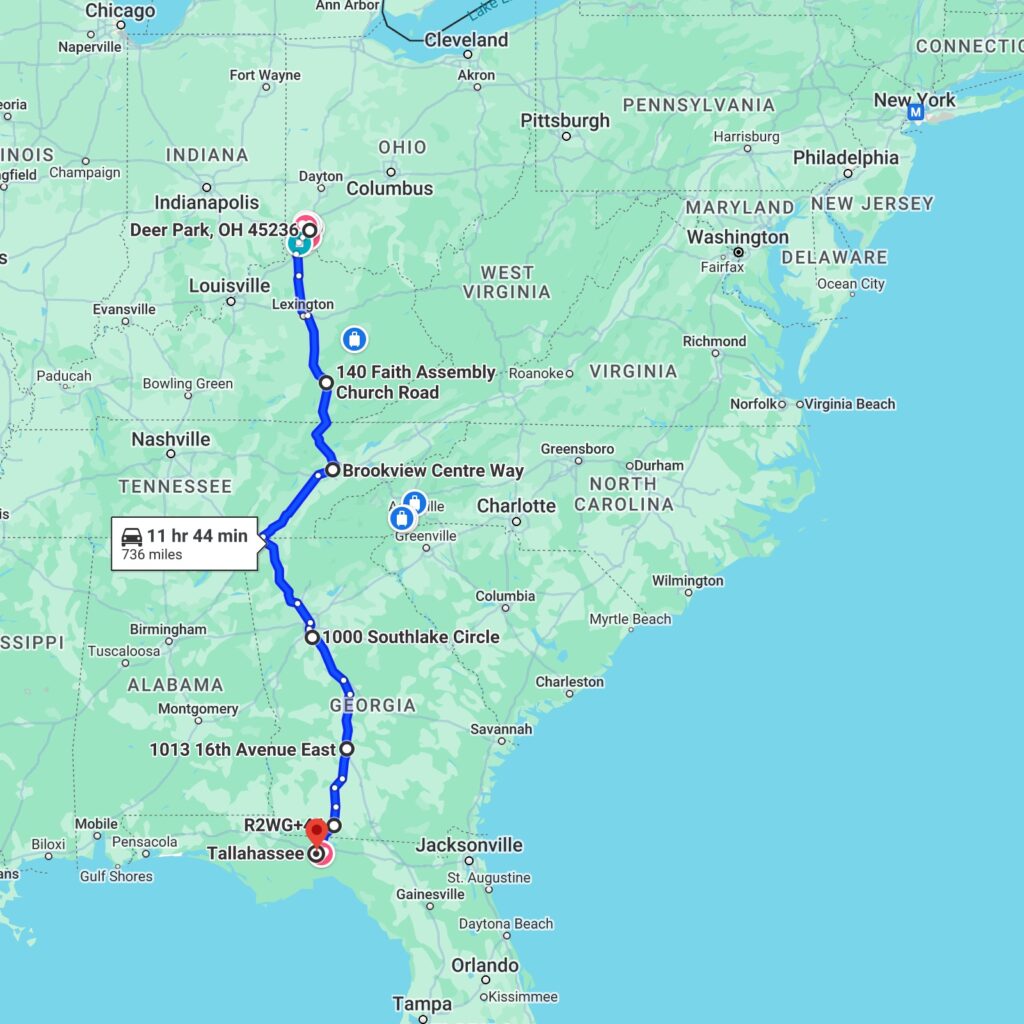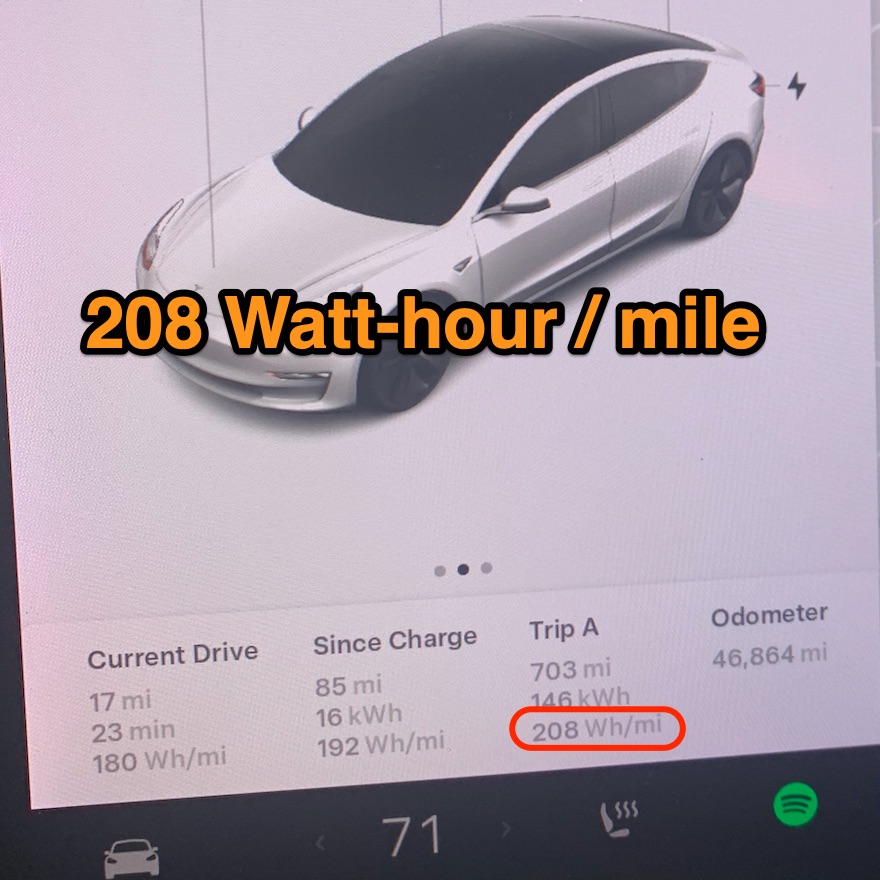In the Fall of 2023, I drove my 2019 Tesla Model 3 from Cincinnati, OH to Tallahassee, FL with an average efficiency of 208 Wh/mi which is 4.8 miles/ kWh. This is pretty outstanding if you ask me. I did limit the heater usage and often drafted behind trucks at a safe “Chill FSD” distance. My interstate cruising speed was generally 65 to 70 MPH, which was below the average car, but matched the average truck cruising speed.
The Route
The primary route is just a drive down I-75 until somewhere in Georgia where I need to determine the best route to Tallahassee. This time, I was able to drive directly through downtown Atlanta. See the route below.

Overall Numbers
This was mostly a pure drive + charge trip except for one extra stop of 27 minutes to get out of the car for a bit longer. The table below shows the full trip details except for one extra stop. I think this is a pretty long drive for one person to do in a single day. I do this drive multiple times during the year, but this is only the second time with my Tesla Model 3. I have been able to complete it about 1 hour faster with a gas car.
| Total Miles: | 738 |
| Number of Charges: | 5 |
| Total Drive hours: | 13.0 |
| Total Charge hours: | 1.6 |
| Trip Total Drive+Charge hours: | 14.6 |
My Optimization Plan
The Tesla navigation computer will direct you when and where to charge to reach your destination. The problem is that it may not match your driving style. Since I was pretty interested in optimizing my driving efficiency while not going TOO SLOW, the Tesla computer was too conservative and NOT helpful for this trip.
Electric vehicle batteries do not charge at a set rate. First, they like to be at an optimal temperature for charging. If the Tesla knows you are headed to a charging station it will preheat the battery to have it be at the optimal charging temperature for the fastest charging. However, if the projected arrival state-of-charge shows that you could run out of juice, the Tesla will not spend the additional energy to heat the battery and will only do so once you start charging.
The biggest impact on charging speed is the batteries’ state-of-charge. When starting from a low state of charge (like 5-20%) they will quickly increase the charging speed to the maximum. Then as they charge the charging rate will decrease. See the chart below from one of my other sites: ChargeDischarge.com.

For this trip, I decided a near-optimal drive charge plan would be to plan on driving 100-150 miles and arrive with about a 10% charge. Then charge enough to do it again for the next leg. This ended up being basically charging from 10-60%, which I think is pretty near perfect for this car. To fine tune the charging in this way, you actually need to do manual calculations. Especially considering if you are “hypermiling” because Tesla uses much more conservative estimates for efficiency and seems to have you arrive with closer to 20% charge left.
The actual battery chemistry and configuration for Tesla vehicles is pretty hidden from end-users. My 2019 SR+ most likely has a NCA (Nickel-Cobalt-Aluminum) battery. More info here.
Average Leg
For this trip, my drive + charge pattern was basically to drive for 2 hours and then charge for 20 minutes. With the charging going from 10→65%.
Numbers per Driving Leg
A bit more interesting is the mix of driving and charging. For those unfamiliar with EV charging and driving, the batteries charge much slower as they fill, so to optimize charging SPEED, you generally want to only charge to a max of 60-80%. My Tesla Model 3 is a Standard Range Plus with a relatively small battery of 57 kWh. The battery has also degraded a bit over its life and leaves me with about 210 miles of expected maximum range.
| Drive | Drive | Drive | Charge | Charge | Cost | |||||
| Charge Stop | Leg | Miles | Charge | Whr/mi | ℉ | Minutes | MPH | Minutes | MPH | $/kWh |
| London, KY | 1 | 164 | 6→59% | 225 | 43 | 152 | 65 | 19 | 352 | $0.33 |
| Knoxville, TN | 2 | 111 | 7→51% | 203 | 60 | 105 | 63 | 17 | 326 | $0.28 |
| Hamilton Place, | 3 | 87 | 10→67% | 204 | 70 | 85 | 61 | 18 | 403 | $0.32 |
| Southlake Mall, GA | 4 | 128 | 10→68% | 197 | 81 | 135 | 57 | 18 | 410 | $0.20 |
| Cordele, GA | 5 | 129 | 10→68% | 214 | 87 | 128 | 60 | 22 | 365 | $0.34 |
| Tallahassee, FL | 6 | 119 | 13% stop | 192 | 204 | 35 |
Optimization Plan
The steps in my optimization plan are:
- Your first drive leg can be longer because you will probably be starting with a higher state-of-charge than subsequent legs. But, just pick a reasonable 1st stop based on what Tesla says or based on your prior experience in hypermiling.
- On arrival at the charging station (or before), pick your next charging stop in the range of 100-150 miles away.
- Calculate how much state-of-charge you need so that you can arrive at that next stop with about 10% battery left. You could be more or less aggressive in doing this.
- With my M3, this is a very easy calculation because each 1% of battery equates very closely to 2 miles of range. So, if there is a good-looking Supercharger 120 miles down my route, I know I’ll need 60% (120/2) of the battery to get there. Add my 10% buffer, to get my target charge of 70%.
- To find the factor for your Tesla, just take your 100% battery range and divide by 100. That will be the number of miles you can get from each 1% of charge.
- Charge to the calculated needed charge.
- Rinse and repeat…
The Tesla computer will be more conservative with its recommended charging stops. Therefore, it actually will act as though you cannot make your destination. I use Google Maps to help find the charging stops base on the calculations explained above. Of course the Tesla is very smart about charging, so it is good to verify that you are not passing up an empty Supercharger location to end up at a crowded one.
Your speed will be the biggest factor effecting your efficiency. I asume you know not to use the cabin heater, although sometimes it is necessary and the newer Tesla’s with heatpump heaters will be much better than the older ones like mine.
Drafting is also beneficial, but I do not like that trucks throw up rocks and debris. Also, the view is not very pleasant right behind a big semi. Also, if the roads are at all hilly, the trucks will be speeding up and slowing down a bunch. Your option.
There are other factors like wind, rain, elevation, road smoothness, and tire pressure. For this trip, I just ran at the recommended 45psi for my car, but I’m thinking of bumping that up next time…
YMMV
